How to Write a Professional Email (7 Easy Steps)
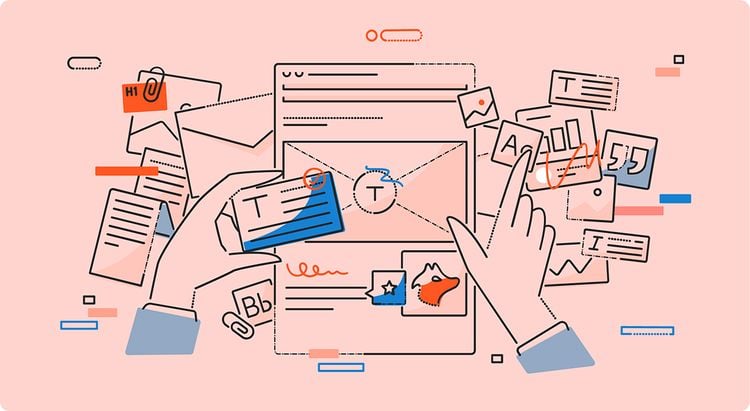
In the era of instant messaging, emails still cover a significant portion of professional communication. Writing well-crafted professional emails is a prerequisite for business interaction and conversation. Apart from a formal tone and language—many other things need to be considered while writing emails.
These can be sent to other companies, colleagues in your company, or cold campaigns to businesses and individuals.
On average, 121 business emails are sent and received by a professional every day. If you want your email to stand out, be opened, and read, you need to craft it professionally—and we’ll tell you how.
In this article, we’ll take a step-by-step approach on how to write a professional email that hooks the receiver and compels them to take the desired action. Whether you send manual emails or leverage tools to automate your emails. This skill can significantly help you in every phase of your professional journey, so let’s begin!
A step-by-step guide on how to write a professional email in 2021
The power of a well-structured professional email that conveys the message in minimum words and gets the reader to take action cannot be overlooked. It’s a must-have skill for every professional for effective communication, especially today, given the remote situation where a large chunk of conversations occurs on email.
Let’s see what steps you need to take while creating the perfect email for business communication in 2021:
Step 1: Think about the purpose, and create an email outline
You can’t just open your email account and start typing. With professionals, you need to be very clear on what you want to communicate so your email aligns with the core message. This ensures that everything is optimized for the recipient to take the intended action.
The first step towards doing this is to identify your purpose for writing this email and what action would help solve that purpose.
For example, if you’re writing a cold email, you would want them to respond with their available time to book a meeting or click on your calendar link to discuss things further.
Take your purpose as the guiding factor to create the outline of your email, which can also act as a template if you have multiple people in the organization sending similar emails every day.
This outline should indicate what you want to say or include to communicate the message clearly. Here are some best practices for doing this:
- Understand who this email is for, and find their correct email address (you can use Hunter for email lookup).
- Write down the purpose and goal of sending the email.
- Find out what language or trigger points will make the receiver act on it.
- Analyze the need for any attachments, like business reports, case studies, or documents for further context.
- Decide on the number of links or call-to-actions you will include to maintain a sweet balance between getting a response and not seeming too salesy.
- Have guidelines for using images to clarify the message further.
- Briefly mention the points you want to cover, so you don’t miss out on them while writing the email eventually.
Here’s an example format of a cold outreach email.
For your outline, you can add pointers under the highlighted elements to ensure you don’t miss out on important information while writing the email.
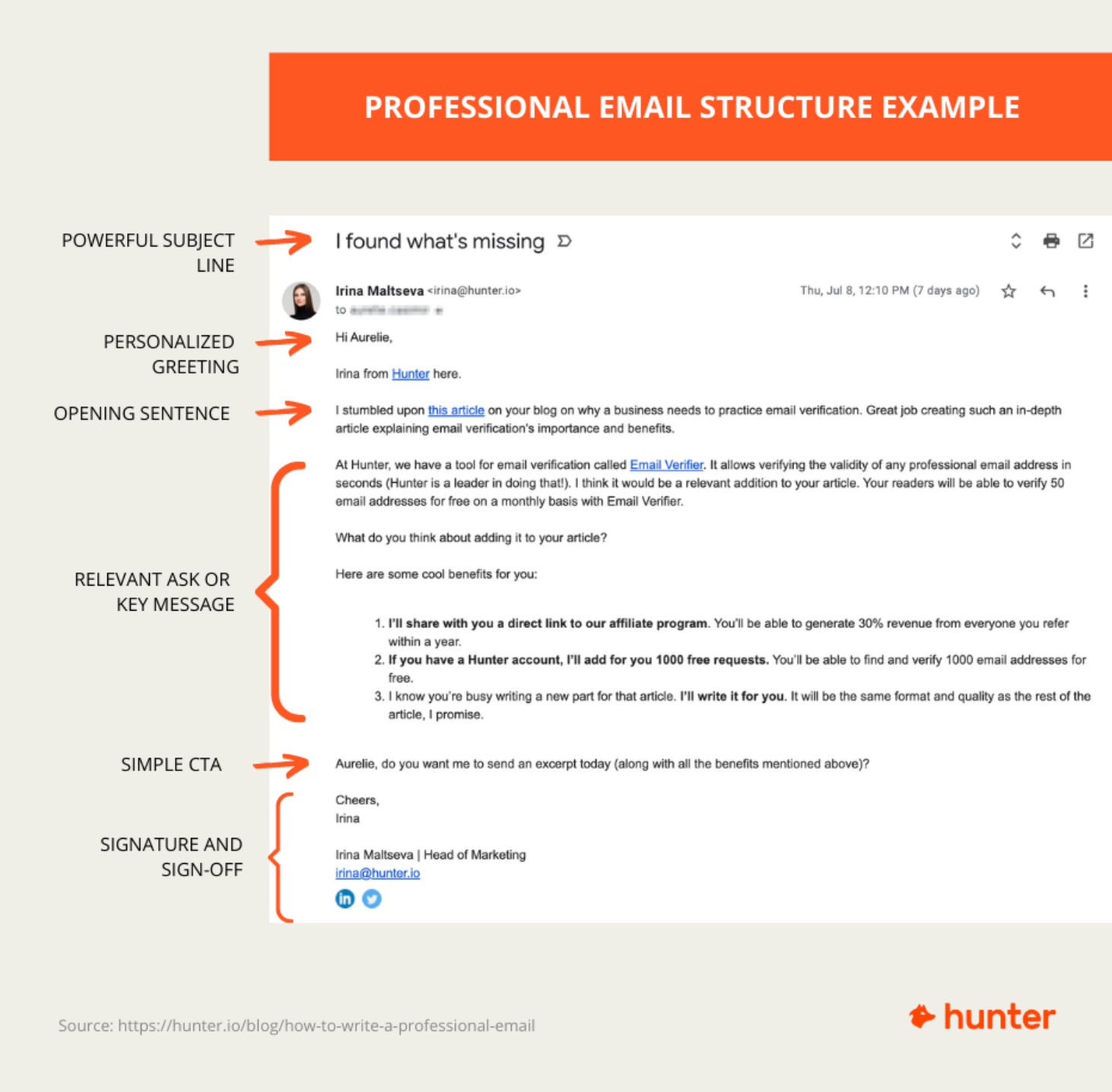
This outline will guide you in writing the ideal email, and if you convert it into a template you can also help other people in your organization craft them better. It’ll also help save time and act as a checklist while writing other emails, so you don’t have to start from scratch every time.
Additional read: How to Write a Cold Email That Converts (Without Being Pushy)
Step 2: Craft a compelling subject line
The subject line is the first thing your receiver will see in the inbox. This one line determines if they will open your email or not, so don’t overlook its importance.
It should determine what you intend to communicate in your email and act as a preview of the body. At the same time, it needs to be persuasive to intrigue the receiver into opening the email.
No matter how well your email body is structured, if the subject line fails to catch their attention, your email might be left unopened, and that’s not what we want.
So, here are some subject line tips for a professional email:
- Keep it shorter than 60 characters. Going beyond this might trim the subject line in the inbox.
- Make it crisp and to the point, without turning around words.
- Highlight the purpose of your email in one sentence.
- Avoid being vague, be as specific as possible.
- Use the receiver’s name as the first word to make it more catchy.

For example, if you want to reschedule a meeting, instead of writing “Request to reschedule,” you can write “{{first_name:"Hey"}}, can we please reschedule the meeting?”
Or, if you want to remind someone of an important task, instead of writing “Reminder,” you can write “Reminder: Please send the list by 10.30 pm.”
While crafting subject lines for cold emails, remember not to mislead the audience by writing a clickbait—it’ll drive the receiver away rather than clicking on your email.
Always be honest and authentic with a clear subject line to communicate your message while respecting their time.
Additional read: 89 Cold Email Subject Lines & How to Craft Them
Step 3: Start with a warm and appropriate greeting
Once you’ve cracked the subject line, you can begin writing the email. In a professional email, the greeting matters a lot. It’s important because you could end up misspelling someone’s name or addressing them with the wrong salutation—all of which can affect their impression of you.
For cold emails, make sure that the greeting is personalized and there there are fallbacks for custom attributes:
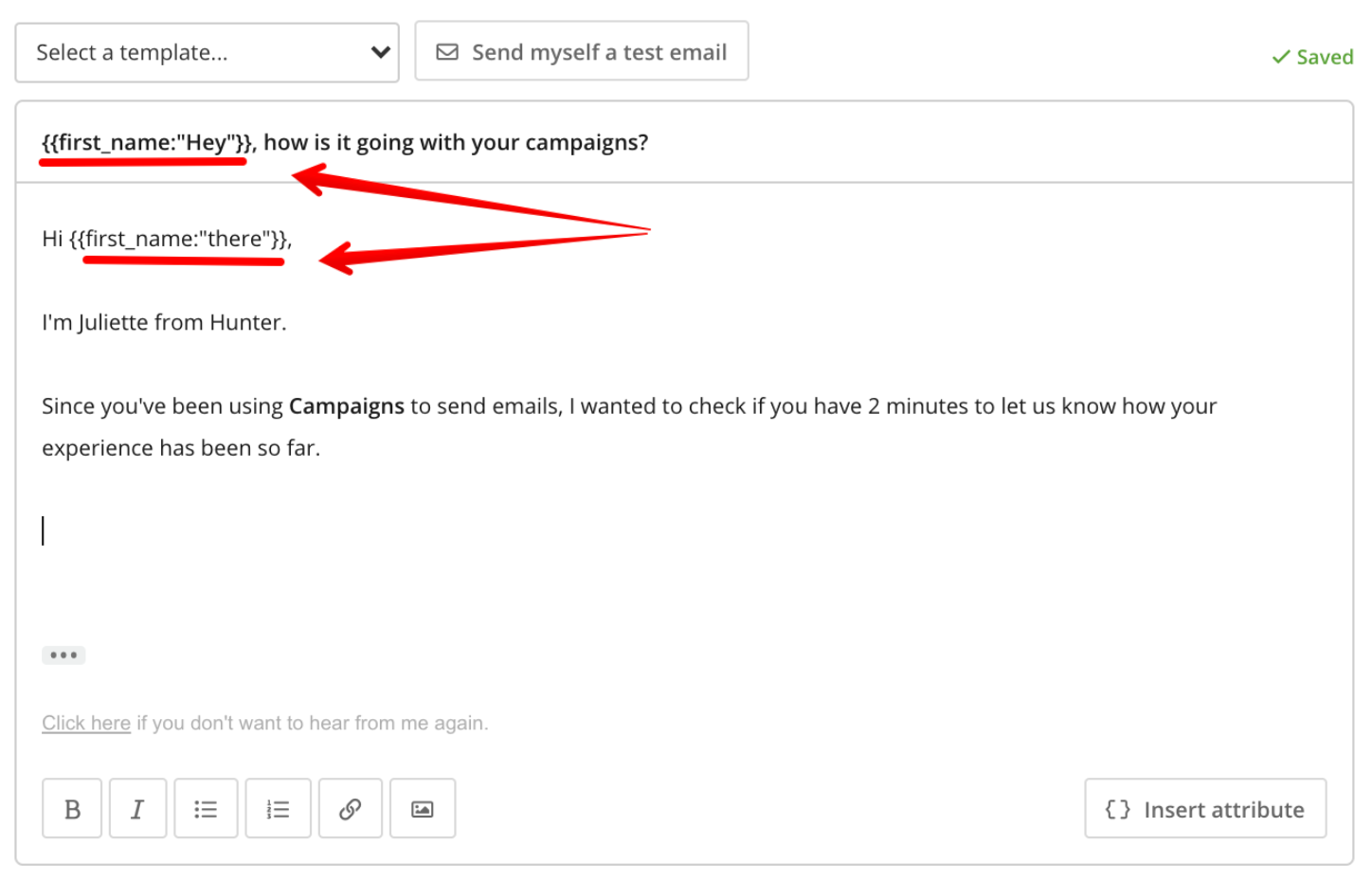
Pay adequate attention to the greeting as it sets the tone for your entire email and determines the likelihood of getting a positive response. Here are a few things to keep in mind:
- Understand the level of familiarity with the receiver. If it’s a colleague, you can use “Hey,” but if it’s someone important, like a member of an organization’s board, then you can use “Dear Mr. (last name),” or “Dear Sir.”
- Don’t assume who will receive the email. If you’re not sure who you’re sending it to, you can use a simple “Hello” or “Hi”.
- Avoid addressing them by their professional role unless necessary. Use the name of the person, instead of saying, “Dear member of the board,” or “To whom it may concern.”
The salutation and greeting are a small yet integral part of a professional email. It can make or break your email efforts, so clarify the relationship with the receiver to write the ideal greeting. Here are some additional tips:
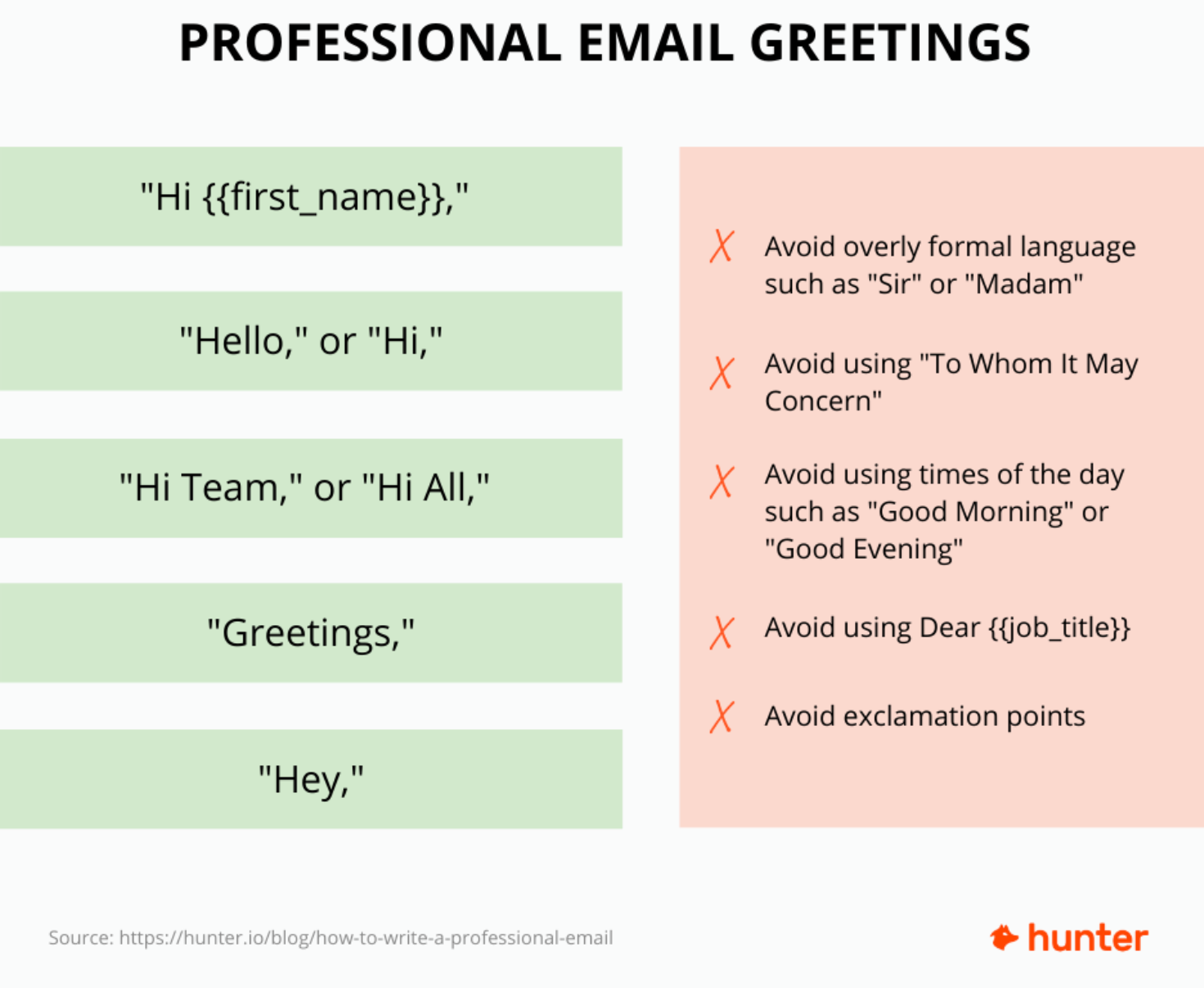
Step 4: Give a brief introduction about yourself
Your email body should always begin with an introduction about yourself after the salutation. You can skip this part if you’re emailing someone who already knows you, as it may seem redundant.
This is significant, especially when you’re emailing someone for the first time or using a different email address to communicate with people who know you. It plays a vital role in business emails because if the recipient doesn’t know who you are, it will be fairly complex for them to get back to you or find any motivation to respond.
This can be a small paragraph of 1-2 sentences about you, which aligns with the purpose of the message. Keep it short and sweet.
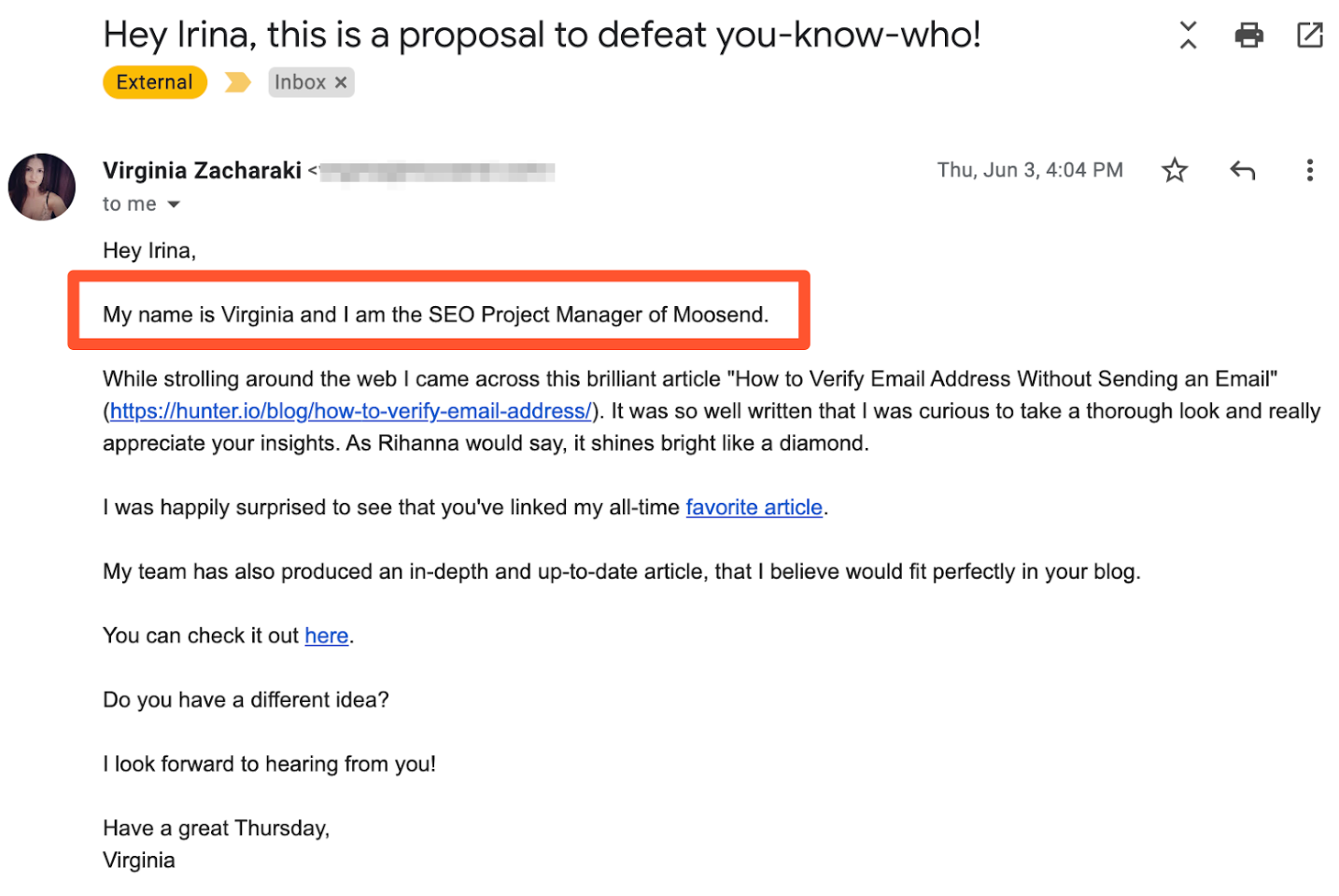
Here are some standard points to keep in mind:
- Avoid adding irrelevant information that doesn’t relate to the email’s core message.
- Restrict your introduction to 1-2 sentences.
- Keep it straightforward, and don’t get into the details.
- Consider hyperlinking your name to your website or LinkedIn profile so they can gather more context about you. (Remember to improve your LinkedIn profile, before you send the campaign)
- If you’ve spoken to the receiver earlier, are familiar with the company, or have met before, you can briefly talk about the instance to find a common touchpoint.
Avoid overcomplicating the introduction, and keep it minimalistic. Here’s an example of a business email opening.
“I’m XYZ and I handle the marketing strategy of [company]. I am reaching out to you because we’re interested in collaborating with you on [whatever].
Providing an intro in cold emails is essential as the prospects don’t know you and want to understand with whom they’re connecting.
Step 5: State your purpose of communication
Once you’ve introduced yourself, you can start communicating the purpose of sending this email. This is the main section of the email body that includes a detailed description of what you want to convey, how the recipient can benefit from it, and what they should do next.
Even though this is the juicy part of your email, keep it brief, and straightforward. No one has the time to read a lengthy email that’s hard to read and lacks context. Pay attention to communicating more in fewer words.
Some tips for writing an excellent email body:
- Avoid fluff and technical jargon—make it very easy to read.
- Optimize the email for skimming by using standard formatting, and bullet points.
- Use bold, italics, and underlining to highlight important points.
- Write short sentences they can read quickly.
- Don’t assume your reader’s knowledge; break it down in an easy-to-understand manner.
- Ask an open-ended question in the end to increase your chances of getting a response.
- Proofread, and check your email for typos (you can use tools like Grammarly for proofreading).
The body section of your email can be tricky because if you make it complicated, the reader might bounce off, or if you make it overly simple, they may not be interested.
The key is to understand the recipient and write it intriguingly, which builds interest in what you’re saying and taking the desired action. The outline in step 1 will help you write this body more effectively.
If you need more inspiration check out this directory of best-performing cold email templates.
Step 6: Use the right sign off
The end of your email is as important as the beginning. It should not leave the recipient hanging but tell them what to do next. Once you’ve explained your purpose in detail, summarize everything in one or two sentences as the closing lines for the body.
At this time, you should also include the call to action. This can be getting a response, clicking on a certain link, or taking a particular action like this.
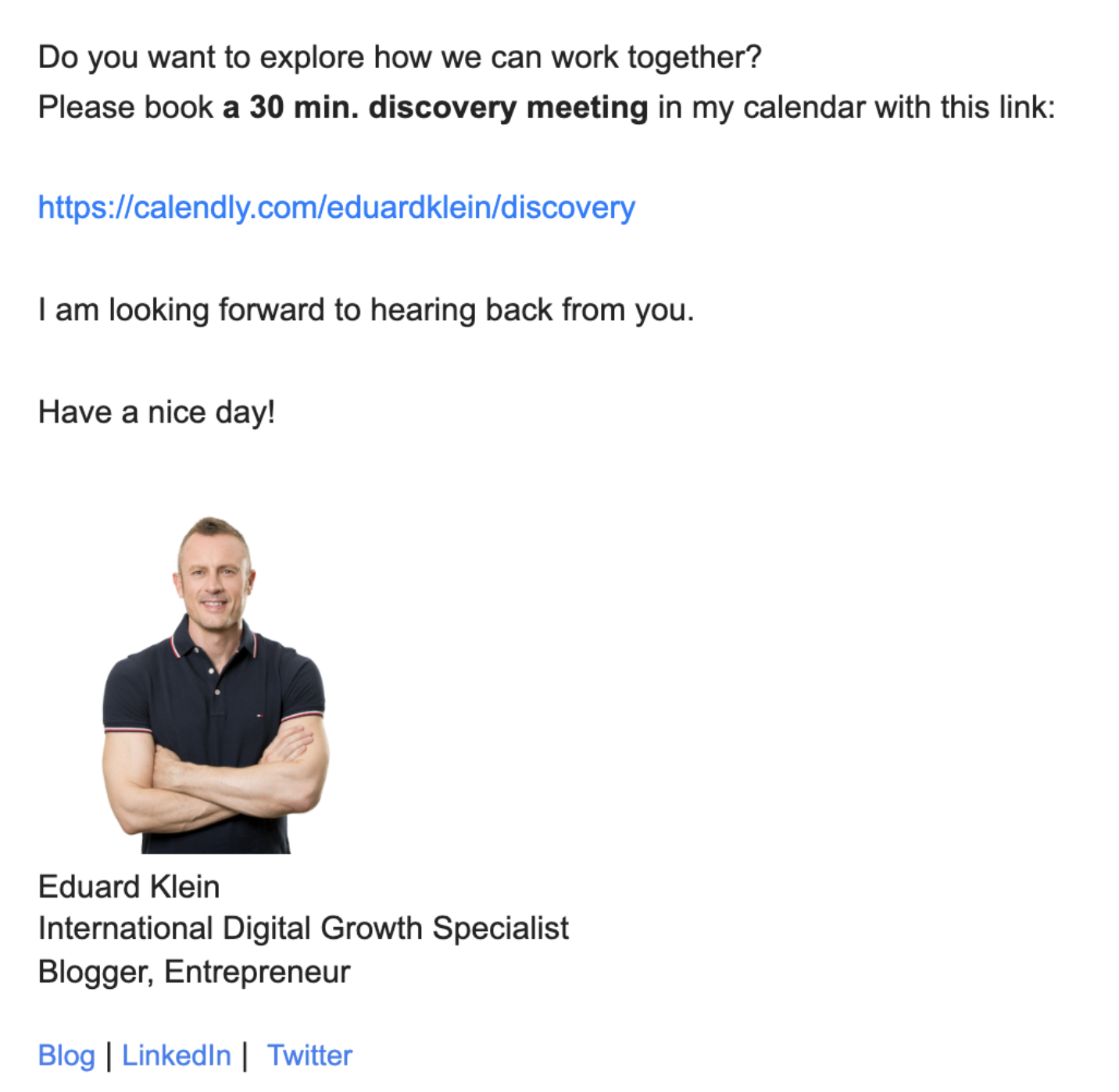
These ending lines and CTA need to be persuasive and highlight the importance of carrying out a particular action.
It all comes down to what the reader does after reading your email. If it’s written well, highlights the value, and includes the proper closing statements—you have a high chance of getting a response or seeing the desired result.
You also need to ensure you use the correct sign-off. Some common ones include:
- Regards
- Best
- Sincerely
- Cheers
- Best regards
- Thanks
- Kind regards
Pick the appropriate sign-off depending on your email’s purpose and your relationship with the audience. The wrong sign-off can create a bad impression as it may come off as being over-familiar or unprofessional.
So, pay attention to your closing statements, and sign off since they significantly determine if the recipient will respond to you.
Additional read: How to End an Email (Don’t Miss These 30 Sign Off Examples)
Step 7: Include an email signature
A professional email signature carries massive potential to provide more context about you or your company and provide details to reach out to you—yet, most professionals don’t tap into this opportunity.
Ideally, this email signature should include:
- Full name
- Role
- Company/website
Extended version may include:
- Headshot
- Social media profiles
- Phone number
Usually, all email marketing services and platforms like Gmail and Outlook allow you to add automatic email signatures to every email, in case you forget. It’s an excellent way to automate this section; however, you can always make changes based on the purpose of your email for a better response.
Best practices for writing professional emails
Writing formal emails is much more than just sticking to these steps. Paying attention to each one of them is essential, but there are some other things you need to keep in mind to make your email stand out and see results for your outreach efforts.
Let’s look at some best practices that can enhance your email and make it response-ready.
1. Keep your email short
This is one of the most challenging aspects of writing emails. Most often, there’s a lot of information to be covered in the body, making it difficult to keep the length under check.
Here’s an example of a crisp email:
However, you must keep it short because of these reasons:
- Professionals, especially the company’s decision-makers, don’t have the time to go through lengthy emails. They only skim through it, and if they come across an extremely long one, they will directly ignore it.
- Because of the massive number of emails professionals receive, they can’t go through long emails even if they want to do it.
- Crisper emails communicate the message quickly.
- It makes it easier for the recipient to respond.
Imagine it yourself—would you be keener to read a short and crisp email that gets to the point quickly or an extremely lengthy email that bores you simply by the look of it. Don’t forget to proofread it before you hit “send.”
An easy way to make your email short is to ask “so what” after every sentence. If there’s no definite answer to it, remove that sentence. Repeat this till you’re left with a concise email that communicates a message clearly, and quickly.
2. Personalize it for the receiver
Nobody likes to receive copy-pasted emails that you can send to everyone. We live in a world where even push notifications by apps are personalized, so doing it for professional emails is a given.
Email personalization doesn’t only mean using the recipient’s name in the subject line or salutation. It refers to including elements that show you’ve done your research and have taken out time to write a good email for them.
Here’s an example of a personalized email template:
74% of marketers say personalization helps get a more significant customer engagement. And so, paying attention to it can significantly increase your email open rate, increasing the chances of getting a response.
The best way to do this is to include a personalized first paragraph in the body. You can go through the recipient’s social media, website, or news features—anything that gives you a starter point to show you’ve done your research.
For example,
“Hey X, I recently saw your social media post on the importance of sales funnels for B2B brands, and I couldn’t agree with it more. I especially loved the second point about understanding the customer’s journey, it was such a great post.”
Even 5-minutes of research to craft a personalized email can skyrocket your chances of getting a response or closing a sale.
For large batches of cold emails, it’s not always possible to manually edit each email by hand. Using tools like Hunter Campaigns can save you hours of your time. Create a CSV with detailed information about your prospects.

And upload them into Hunter Leads to personalize your emails in bulk automatically.
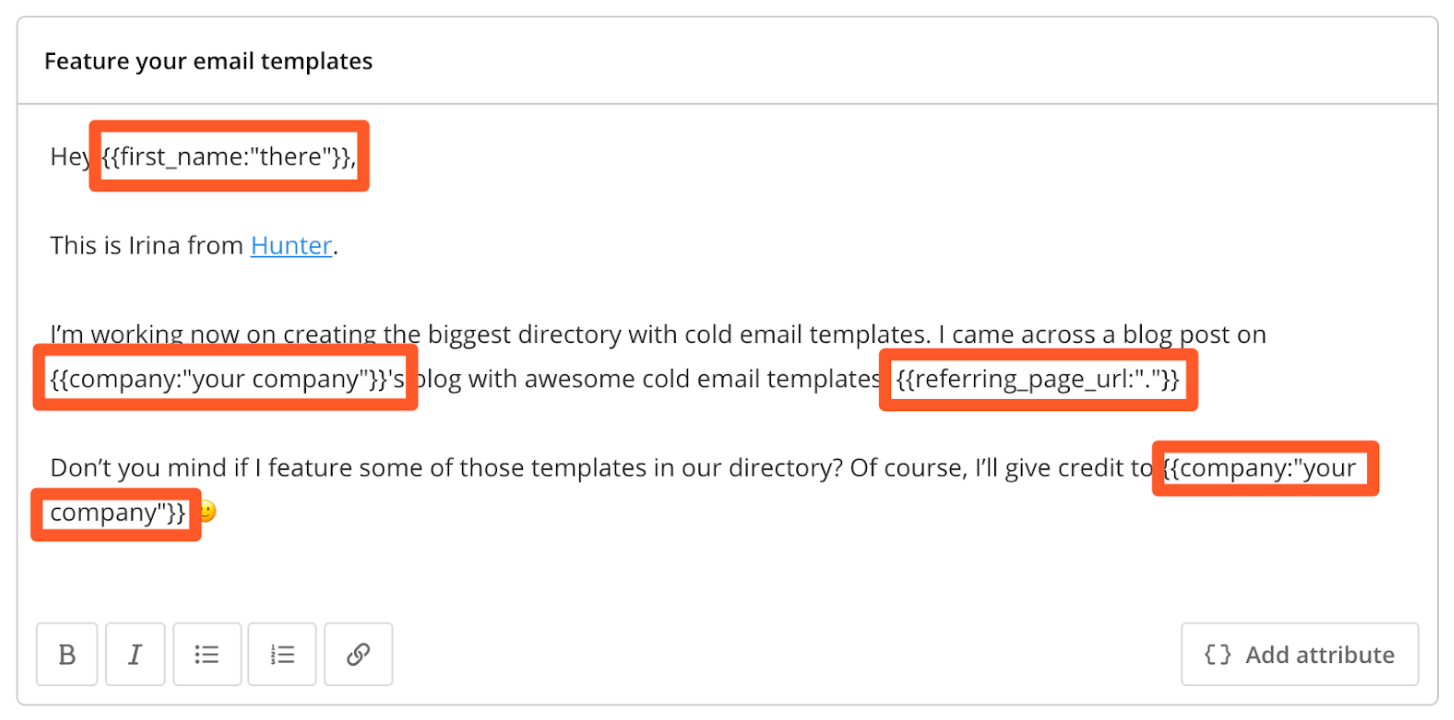
3. Don’t use slang or jargon
Using slang, messaging language, or technical jargon in emails are the biggest red flags for professional emails. Since these emails are written for business communication with immense value, slang, and jargon decrease professionalism and go against business email etiquette.
It can also be perceived as disrespectful, so avoid using these, and stick to business language that’s simple, easy to understand, and communicates the message in a professional tone of voice. Using it can also give a casual impression to the recipient, causing them not to take your business and email seriously.
The key reason why you should avoid slang is that it can give out the wrong impression, cause confusion or offend someone. With jargon, your email language becomes complicated, making it difficult for the recipient to understand what you’re trying to say.
Here are some simple phrases that can help cut out the need for slang and jargon, making the email simple, and professional.
Examples:
- “Might I take a minute of your time..”
- “I’m just emailing to ask..”
- “I would like to follow up making sure you got my previous email”
- “Would you be so kind…”
- “I really appreciate you finding some time to answer my email”
All of these situations must be avoided by sticking to business communication and a formal tone of language. So, after you’re done writing the email, double-check for these.
4. Always follow up
Sending an email as a follow-up is essential to jog the recipient’s memory and remind them to give you a response. Sometimes, professionals get busy, the email gets lost in the inbox, it might land into spam, or they might be looking for a further nudge to give you a response.
If you don’t get a response to your first email, then there’s a 21% chance to receive a reply to the second email. Sometimes we feel afraid of sending follow-ups and that our prospects feel stalked and angry. In fact, many of them feel grateful and admire your persistence. Especially if you send out cold email outreach and the prospects don’t know you, reading multiple of your emails generates a feeling of familiarity.
Don’t undermine the power of follow-up emails, and always use it to your advantage while keeping these points in mind:
- Gently remind them of your last email while maintaining professionalism. Don’t be pushy.
- Touch base on the purpose of this email.
- Provide additional information by mentioning something worthy. If it was a sales email, you can send them a few testimonials or a link to a case study. If it was a recruitment email, you can pass down references or highlight a skill by telling an instance where you solved a particular problem.
- Include one catchy call-to-action with a persuasive closing that gets them to reply.
Keep the follow-up brief and try to get to the point as quickly as possible. This doesn’t have to be as detailed as your first email. It would be best to create a template for a 2-email sequence for follow-ups so you can be ready to respond.
Here’s an example of a good follow-up email.
Ideally, wait for 3-5 business days before you follow up for the first time. This will give your prospects enough time to respond and for you to prepare the following email.
It’s not always possible for huge email volumes to remember when you need to send each follow-up and stick to your schedule.
Fortunately, tools like Hunter Campaigns can help you save time preparing and scheduling highly-personalized cold email follow-ups.
With Campaigns, you can choose how many follow-ups after no response you want to send, specify the time delays between each follow-up, personalize the subject line, and work on the email copy.

Additional read: How to Write a Follow-Up Email After No Response
Conclusion
Writing a professional email is an important skill, especially because so many professionals receive emails every day. In this crowd, if you can write an email that stands out and gets a response—it’ll help you in every part of your professional life, be it in a job, freelancing or business.
Communicating with professionals effectively is essential to form a connection and build interest in what you do. Even if you pay attention to this while communicating with colleagues or seniors within your organization, people will praise and remember you as business communication skills are highly valued in every industry.
Use this guide to write a perfect professional email that offers better
comprehension and gets a good response.




 Send cold emails with Hunter
Send cold emails with Hunter